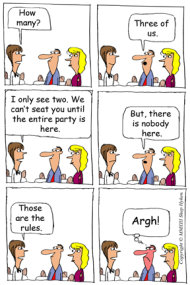 Customer Service Rules vs. GuidelinesLessons about Customer Service
Customer Service Rules vs. GuidelinesLessons about Customer Service
Sometimes “company policy” drives me crazy. Often policies are perceived as unbendable rules. When it comes to customer service, the words policies and rules may not be the best choice of words for creating a customer focused environment. The story I’m about to share is filled with lessons about customer service. You’ve probably even had this happen to you.
Three of us walked into a restaurant for dinner. A fourth person was going to join us, but he was running late. He said to start without him.
We told the hostess we needed a table for four. There were several open tables. She noticed there were just three of us and asked where the fourth was. We told her he was running late and we were going to order without him. That’s when she said:
I’m sorry. We can’t seat you until your entire party is here.
Although we told her he was running late and we wanted to order without him, it made no difference to her. She was following the company “policy”. By the way, I can appreciate the restaurant’s position. Some guests sit at the table and don’t order until the rest of the party shows up. In that case, I understand. Good restaurants tell their guests they will be seated at the very next table once the rest of the party arrives. Good solution, but that didn’t apply to this situation.
Now, back to the story. What happened next could have come from a script from Seinfeld.
I said, “Okay there are only three of us. We need a table for three.
She said, “Sir, you’re lying to me.”
Darn, she caught me. (I’m being sarcastic.) I said, “Just give us a table for three.”
I thought for sure she would start to argue with me. After all, she apparently wanted to follow the rules and she had just called me a liar. But she didn’t argue. Instead she grabbed three menus and immediately seated us at a table… that had four chairs!
This is the kind of situation that really makes my blood boil. How many customers has she upset in the past – or will upset in the future?
Consider this:
- The employee was just doing her job. She was probably told by a boss not to seat incomplete parties. In the restaurant business, this usually applies to situations where there is large party and the first person shows up.
- She was not empowered to make good decisions on behalf of the customer.
- She probably wasn’t trained properly on how to make those good decisions.
- And if she was trained, whoever hired her may have made a bad hiring decision.
Let’s assume this employee is a good person, who with training can understand and deliver a good customer service experience. It’s okay to have some guidelines and boundaries. Be careful about calling them rules or policies. The word “guideline” implies some flexibility. Employees must understand that they bend to meet the needs of the customer, as long as it doesn’t cause harm to the company.
If you have the right system in place and the customer service experience is clearly defined, you are off to a good start. Recognize that it is your people that will deliver on the experience, so choose them wisely. Hire people that understand customer service. Teach them how to deliver your brand of customer service. Coach them when you see opportunities to improve. Praise them when you see them doing it right.
More Business articles from Business 2 Community:




